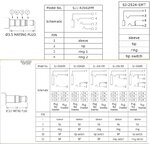JonDrBrown
Newbie level 3
I am building a compact 2W stereo amplifier to work primarily with a smartphone audio output. To keep components to a minimum I have elected to have the unit power up only if there is a jack in the unit’s audio in socket. This is done by routing the 0 volts line from the battery to the amp via the sleeve connections on the jack socket – i.e. via the jack plug’s sleeve itself.
However, when connecting up a smartphone or laptop in this way, distortion arises which doesn’t happen when connecting the supply rail directly to the battery, or via a simple switch – which is what I’m trying to avoid. I suspect that this distortion occurs because a similar ‘auto-detect’ arrangement is in use in the source devices, i.e. smartphone / laptop, and that this is causing problems with disparate dc voltages / 0 volt levels.
Is this problem ‘created’ at the source device, or is it manifesting in the amplifier itself, and how, if at all, can I work around it?
However, when connecting up a smartphone or laptop in this way, distortion arises which doesn’t happen when connecting the supply rail directly to the battery, or via a simple switch – which is what I’m trying to avoid. I suspect that this distortion occurs because a similar ‘auto-detect’ arrangement is in use in the source devices, i.e. smartphone / laptop, and that this is causing problems with disparate dc voltages / 0 volt levels.
Is this problem ‘created’ at the source device, or is it manifesting in the amplifier itself, and how, if at all, can I work around it?


